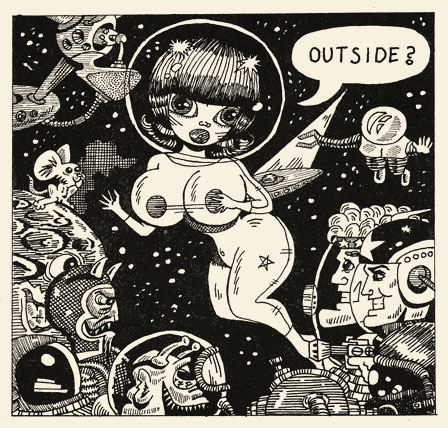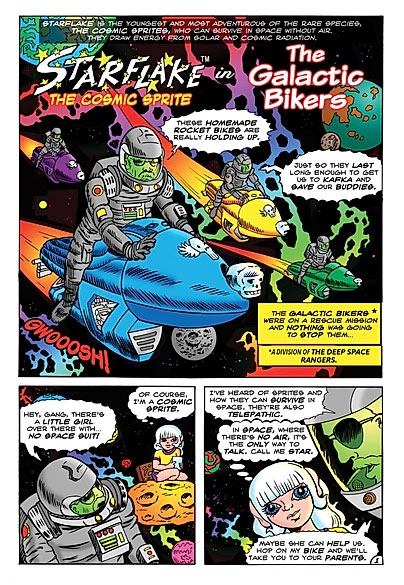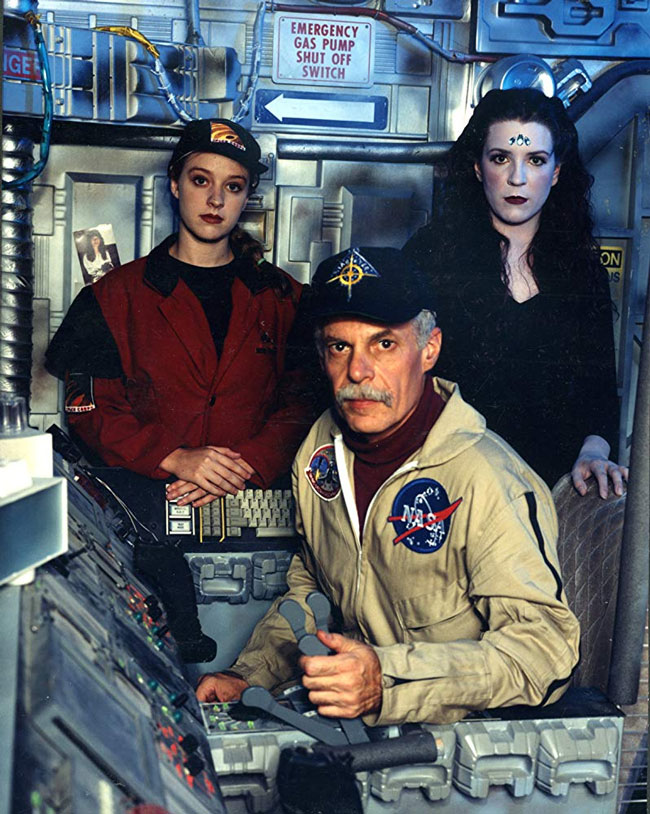'Moonchild'.
Nick Cuti was an American writer, artist and editor of comic books, as well as a science fiction novelist and filmmaker. He first came to notice in the 1960s with the underground comix series 'Moonchild the Starbabe' (1968-1979), before becoming a prominent scriptwriter and editor for Charlton Comics, Warren Publishing and DC Comics. He is best-known for co-creating 'E-Man' (1973-2006), 'Mike Mauser' (1975) and 'Captain Cosmos' (1997-2006) with Joe Staton, while he was also active in the fields of animation and magazine illustration.
Early life
Nicola Cuti was born in 1944 in Brooklyn, New York City, into a family of Italian origins. Between 1966 and 1972, he served in the U.S. Air Force, during which he was stationed in France, Turkey and Bangor, Maine.
Moonchild (1)
While stationed as a U.S. airline pilot in France, Cuti published his first comic strip in the magazine Singular-Plural. It introduced 'Moonchild the Starbabe' (1968), a voluptuous gamine who travels through space without a spacesuit - in fact without much clothing at all. Cuti returned to the character on several occasions throughout his career. First in a series of three underground comix books, published between 1968 and 1970. The second series was produced in cooperation with Gary Arlington's San Francisco Comic Book Company, as one of the first underground comix published in color. In 1972, Moonchild reappeared in the underground anthology 'Weird Fantasies' (1972) by the Los Angeles Comic Book Company, Poor Richard's Adzine #3 (1974) and in the men's magazine Cheri (1978-1979). Much of this material, as well as previously unpublished stories from the early 1970s, were in 1992 collected in the three-issue 'Moonchild' series by Apple Press.
Warren Publishing
In 1969, Cuti's professional career as a comic book scriptwriter took off when he sold his story 'Grub!' to Warren Publishing. It was illustrated by Tom Sutton and published in Creepy #28 of August 1969. He remained a prominent scriptwriter for Warren's horror titles, providing over a hundred stories for Eerie, Creepy and Vampirella until 1973 and then again from 1976 to 1978. Sutton illustrated several of them, as did Russ Heath, Jack Sparling, Ernie Colon and a host of Spanish artists. The publisher awarded him their in-house Ray Bradbury Award on two occasions.
Work for Ralph Bakshi and Wallace Wood
Shortly after leaving the Air Force in the early 1970s, Cuti had a brief stint working as a background artist for Ralph Bakshi in the Krantz Animation Studio. Also during the early 1970s he served as one of Wallace Wood's co-workers in the master's Long Island studio. Among his tasks were assisting on the 'Sally Forth' and 'Cannon' strips for The Overseas Weekly, a magazine published in Germany for American military personnel stationed in Europe.
'The Weirdlings', from Ghostly Haunts #34.
Charlton Comics
Cuti had already proven his specialization in well-crafted sci-fi and horror plots with ironic twists during his tenure at Warren Publishing. Between 1972 and 1976, he expanded his expertise at Charlton Comics, where he not only worked on horror, but also on romance, war and humor scripts. Besides working as assistant editor to George Wildman, he relieved Joe Gill from his workload as the company's main scriptwriter. During a period of four years, Cuti wrote stories in all sorts of genres for Charlton's many anthology titles. While the company published mainly budget comic books and the pay was low, Cuti enjoyed the creative freedom and lack of restrictions. He was free to write for whatever title he wanted, and to experiment with idiosyncratic narratives. His stories for titles like 'The Many Ghosts of Doctor Graves', 'Haunted', 'Scary Tales' and 'Ghost Manor' were illustrated by such artists as Pete Morisi, Steve Ditko, Wayne Howard, Tom Sutton, Joe Staton and Don Newton. As an editor, he recruited new talents like Alan Kupperberg, John Byrne and Mike Zeck. A regular assignment for Cuti was scripting Charlton's 'Popeye' comic books, mostly drawn by George Wildman. Cuti occasionally turned to the drawing board himself, most notably for the bizarre humor strip 'The Weirdlings', a back-up feature in several Charlton ghost titles.
E-Man
Nick Cuti's best-known and most enduring creations for Charlton were made in cooperation with artist Joe Staton. No fan of serious and dramatic superhero comics, Cuti turned his 'E-Man' (1973-1975) into something else. Taking inspiration from Jack Cole's 'Plastic Man', the science fiction novels of Arthur C. Clarke and Einstein's mass-energy equivalence, the comic maintained a lightweight, humorous, but still action-packed tone. The superhero E-Man originates from the nova of an unnamed star. Releasing energy, the star nova has consciousness and a keen sense of curiosity. After traveling through outer space for millions of years, the nova develops the capability of transforming in any shape it wants. Taking a human form, it becomes E-Man, a superhero who assumes the human identity of Alc Tronn. On his chest he wears Einstein's famous relativity theory, 'E = mc2'. E-Man is able to fire energy blasts from his hand. He teams up with the exotic dancer Nova Kane. E-Man and Kane later befriend a pet koala, Teddy Q, who grows such intelligence that he ends becoming a bar waiter. A supporting character from the third 'E-Man' comic book, the grubby detective Michael Mauser, was quickly promoted to his own back-up feature in Charlton's 'Vengeance Squad' title in 1975.
Starting as a bimonthly comic book in October 1973, Charlton already canceled the title after ten issues. With its ironic set up, 'E-Man' proved too offbeat to become a commercial success. Throughout the years, it however acquired somewhat of a cult status, and was picked up by indie publishers on several occasions. Between 1983 and 1986, Staton initially relaunched the title at First Comics with writer Martin Pasko, with Cuti returning only for the last two issues. First Comics also reissued the original Charlton stories in the comic book series 'The Original E-Man and Michael Mauser' (1985-1986). 'E-Man' then returned in a one-shot and three-issue miniseries at Comico (1989-1990), after which Alpha Productions published 'E-Man' (1993) and 'E-Man Returns' (1994). Three more one-shots were created by Cuti and Staton in 2006, and released through Digital Webbing Press.
'Wacko', page from Heavy Metal magazine (v9#6, September 1985).
DC Comics
After his departure from Charlton Comics in 1976, Cuti briefly served as assistant editor for Louise Jones at Warren Publishing, before he was hired in a similar role at DC Comics. He initially assisted editor Len Wein, and was then appointed to edit the company's digest titles like 'Adventure Comics' and 'The Best of DC' (1979-1986), which featured reprints of old DC humor comics, among other genres. In addition, Cuti scripted an occasional comic story, like two 'Phantom Stranger' stories for 'The Saga of the Swamp Thing' (art by Fred Carrillo) and the final installments of 'The Creeper' for 'The Flash' (art by Chuck Patton), both in 1983. With artist Tom Mandrake, he made the six-issue space opera 'Spanner's Galaxy' (1984-1985). In addition to his daytime job, he continued to draw, using a scratchboard technique inspired by pulp artist Frank Kelly Freas. His illustrations appeared in sci-fi magazines like Analog, Amazing Stories and Heavy Metal, but also in Alfred Hitchcock's Mystery Magazine.
Movie industry
In 1986, Cuti and his family moved to California, following an offer from his former Warren editor Bill Dubay to become a background artist for Marvel Films. He spent the next sixteen years at the West Coast, doing freelance background and lay-out designs for productions by The Walt Disney Company, Universal Studios, Sony Pictures and Sunbow Entertainment, including 'Conan the Adventurer', 'Defenders of the Earth', '101 Dalmatians: The Series', 'Dilbert', 'Street Fighter: The Animated Series', 'Exo-Squad', 'Starship Troopers', 'Jungle Cubs', 'RoboCop: Alpha Commando' and other TV series. By 2003, Cuti relocated to Florida, where he ventured into writing and producing independent films. Initially working through Creature Productions, he later formed his own production company, Ni-Cola Entertainment LLC. Several of his short films were based on scripts he had written for Warren or Charlton, such as 'Grub' (2005), 'Shock House' (2011), 'Tagged!' (2011) and 'The Lady Without Substance' (2012).
Captain Cosmos
Cuti occasionally returned to comic books. With his regular partner in crime Joe Staton, he created 'Captain Cosmos, The Last Starveyer' (1997-2006), a homage to the TV space operas of his childhood. Four comic books were published through indie labels like Hamilton Comics, Ybor City Publishers and Ni-Cola Productions with long interludes. Cuti didn't limit himself to one medium for this new creation, however. He also used the character in his prose novel 'Spin a Web of Death' (2000), three radio plays, three short TV films and the full-length feature film 'Captain Cosmos and the Gray Ghosts' (2007) with Cuti himself in the title role.
Moonchild (2)
In Florida, Cuti also resumed his first creation, 'Moonchild, the Starbabe'. MU Press released three new issues which contained the story arc 'Moonie and the Spider Queen'. The series title was changed to 'Moonie', most likely to avoid confusion with the not-related manga series 'Moon Child' (1989-1993) by Reiko Shimizu. Dave Simons provided the inking and lettering duties. The character also appeared in the illustrated text novels 'Moonie and the Spider Queen' (2009), 'Moonie in the Slave Market of Opuul' (2010), ', 'Moonie in Too Many Moons' (2010), 'Moonie Moonie Goes to War' and 'Moonie and the Space Pirates'; the latter written by Cuti's friend Vic Stonecypher. A lifelong dream of turning his oldest creation into a film came true on 16 August 2013, when his live action film 'Moonie and the Spider Queen' premiered at the Tampa Bay Fetish Con. Moonie was portrayed by Nikoma DeMitro, who also became Cuti's business partner and bought the full 'Moonchild' franchise from its creator in 2018.
'Starflake'.
Starflake
Cuti in turn continued with another creation, 'Starflake the Cosmic Sprite' (2013-2019). Just like Moonchild, Starflake traveled through space with no life support, but her adventures were aimed at younger girls. She initially starred in a novel series containing 'Starflake on Thrill World' (two volumes, 2013, 2016), 'Starflake Rides with the Galactic Bikers' (2016), 'Starflake Hunts the Power Beast' (2017), 'Starflake Aboard the Doomed Ships' (2017), 'Starflake Picks the Junkyard Planet' (2017) and 'Starflake Fires the Glass Ray Gun' (2019). Kevin Glover's Scary Tales Publishing published two comic books, written and drawn by Cuti and inked, lettered and colored by Donnie Pitchford.
Recognition
In 2009, during the San Diego Comic-Con International, Nicola Cuti was awarded the Inkpot Award for career achievement.
Legacy
Nick Cuti passed away in Tampa, Florida on 21 February 2020 following a battle with cancer. He was 75 years old. Following his death, he was praised by fans and colleagues alike for his versatile work, bridging several genres and media. Former DC President Paul Levitz remembered him as a man with a positive outlook on life, which reflected in the playful characters he created.
Nicola Cuti as Captain Cosmos in 2007.












